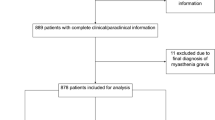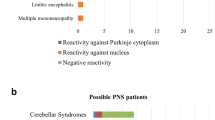Abstract
Paraneoplastic neurological syndromes (PNS) are remote effects of cancer. They are much less common, but are nevertheless important because they cause severe neurological morbidity and mortality. The present cases were studied to characterize the clinical features of patients of suspected PNS and to study their association with different types of tumors. In this study conducted from a super speciality teaching institute from South India, forty five (incidence-0.25 %) patients were diagnosed with PNS based on the clinical data. They were subdivided into two groups patients with central nervous system (CNS) manifestations and those with neuromuscular manifestations. Immunological markers were assessed in a subset of patients. Majority of them (75.6 %) were above 40 years. There was no sex predilection and a chronic presentation was common (42.2 %). While more than half had involvement of peripheral nervous system (64.4 %), CNS manifestations were present in 16 (35.6 %) cases. Immunological markers were present in 10 out of 14 (58.8 %) patients. Classic PNS was seen 22 cases (48.9 %), while 23 (51.1 %) were non classical. Most common tumor was lung cancer followed by myeloma and breast carcinoma. Present study construed that, in patients with neurological syndromes of unknown cause, search should be focused for occult malignancy based on the phenotype and onconeural antibodies, targeting the lung and breast in particular.





Similar content being viewed by others
References
Darnell RB, Posner JB (2003) Paraneoplastic syndromes involving the nervous system. N Engl J Med 349:1543–1554
Denny-Brown D (1948) Primary sensory neuropathy with muscular changes associated with carcinoma. JNNP 11:73–87
Posner JB (1995) Paraneoplastic syndromes. In: Posner JB (ed) Neurologic complications of cancer. FA Davis Co, Philadelphia, pp 353–385
Honnorat J, Antoine J-C (2007) Paraneoplastic neurological syndromes. Orphanet J Rare Dis 2:22
Wani MA, Dar JA, Khan MA, Rehman A (2001) Paraneoplastic limbic encephalititis associated with bronnchogenic carcinoma: a case report. Neurology 49:185–187
Vernini S, Lennon VA (2004) Auto antibody profiles and neurological correlations of thymoma. Clin Cancer Res 10:7270–7275
Varadarajulu R, Narayanaswamy AS, Kasthuri AS (1991) Neurological manifestations of malignant diseases. J Assoc Physicians India 39(5):377–378
Latov N (1995) Pathogenesis and therapy of neuropathies associated with monoclonal gammopathies. Ann Neurol 37(Suppl):S32–S42
Sutton I, Winer JB (2002) The immunopathogenesis of paraneoplastic neurological syndromes. Clin Sci 102:457–486 (Great Britain)
Graus F, Delattre JY, Antoine JC et al (2004) Recommended diagnostic criteria for paraneoplastic neurological syndromes. J Neurol Neurosurg Psychiatry 75:1135–1140
Antoine JC, Camdessanche JP (2007) Peripheral nervous system involvement in patients with cancer. Lancet Neurol 6(1):75–86
Oh SJ (1997) Paraneoplastic vasculitis of the peripheral nervous system. Neurol Clin 15(4):849–863
Levine SM (2006) Cancer and myositis: new insights into an old association. Curr Opin Rheumatol 18(6):620–624
Cl Hill, Zhang Y, Sigurgeirsson B et al (2001) Frequency of specific cancer types in dermatomyositis and polymyositis: a population based study. Lancet 357:96–100
Peterson K, Rosenblum MK, Kotanides H, Posner JB (1992) Paraneoplastic cerebellar degeneration, I: a clinical analysis of 55 anti-Yo antibody–positive patients. Neurology 42(10):1931–1937
Shams’ili S, Grefkens J, de Leeuw B et al (2003) Paraneoplastic cerebellar degeneration associated with antineuronal antibodies: analysis of 50 patients. Brain 126:1409–1418
Vitaliani R, Mason W, Ances B, Zwerdling T, Jiang Z, Dalmau J (2005) Paraneoplastic encephalitis, psychiatric symptoms, and hypoventilation in ovarian teratoma. Ann Neurol 58(4):594–604
Vincent A, Buckley C, Schott JM et al (2004) Potassium channel antibody associated encephalopathy: a potentially immunotherapy-responsive form of limbic encephalitis. Brain 127(pt 3):701–712
Vincent A, Buckley C, Schott JM et al (2004) Potassium channel antibody associated encephalopathy: a potentially immunotherapy-responsive form of limbic encephalitis. N Engl J Med. 349(16):1543–1554
Buchbinder R, Forbes A, Hall S et al (2001) Incidence of malignant disease in biopsy proven inflammatory myopathy, a population based cohort study. Ann Intern Med 134:1087–1095
de Janet W, Smitt PAS (2006) Managing paraneoplastic neurological disorders. Oncologist 11:292–305
Keime-Guibert F, Graus F, Fleury A et al (2000) Treatment of paraneoplastic neurological syndromes with antineuronal antibodies (anti-Hu, anti-Yo) with a combination of immunoglobulins, cyclophosphamide and methylprednisolone. J Neurol Neurosurg Psychiatry 68(4):479–482
Graus F, Dalmau J, Rene´ R et al (1997) Anti-Hu antibodies in patients with small-cell lung cancer: association with complete response to therapy and improved survival. J Clin Oncol 15(8):2866–2872
Uchuya M, Graus F, Vega F, Rene´ R, Delattre JY (1996) Intravenous immunoglobulin treatment in paraneoplastic neurological syndromes with antineuronal autoantibodies. J Neurol Neurosurg Psychiatry 60(4):388–392
Widdess-Walsh P, Tavee JO, Schuele S, Stevens GH (2003) Response to intravenous immunoglobulin in anti-Yo associated paraneoplastic cerebellar degeneration case report and review of the literature. J Neurooncol 63(2):187–190
Vernino S, O’Neill BP, Marks RS, O’Fallon JR, Kimmel DW (2004) Immunomodulatory treatment trial for paraneoplastic neurological disorders. J Neurooncol 6(1):55–62
Acknowledgments
We sincerely thank Professor Lauria Pinter Giuseppe for his valuable suggestions and help in preparing our manuscript.
Author information
Authors and Affiliations
Corresponding author
Ethics declarations
Conflict of interest
None.
Rights and permissions
About this article
Cite this article
Kanikannan, M.A., Sirisha, Y., Uppin, M.S. et al. Incidence and spectrum of paraneoplastic neurological syndromes: single center study. J Neurooncol 125, 197–206 (2015). https://doi.org/10.1007/s11060-015-1898-7
Received:
Accepted:
Published:
Issue Date:
DOI: https://doi.org/10.1007/s11060-015-1898-7




